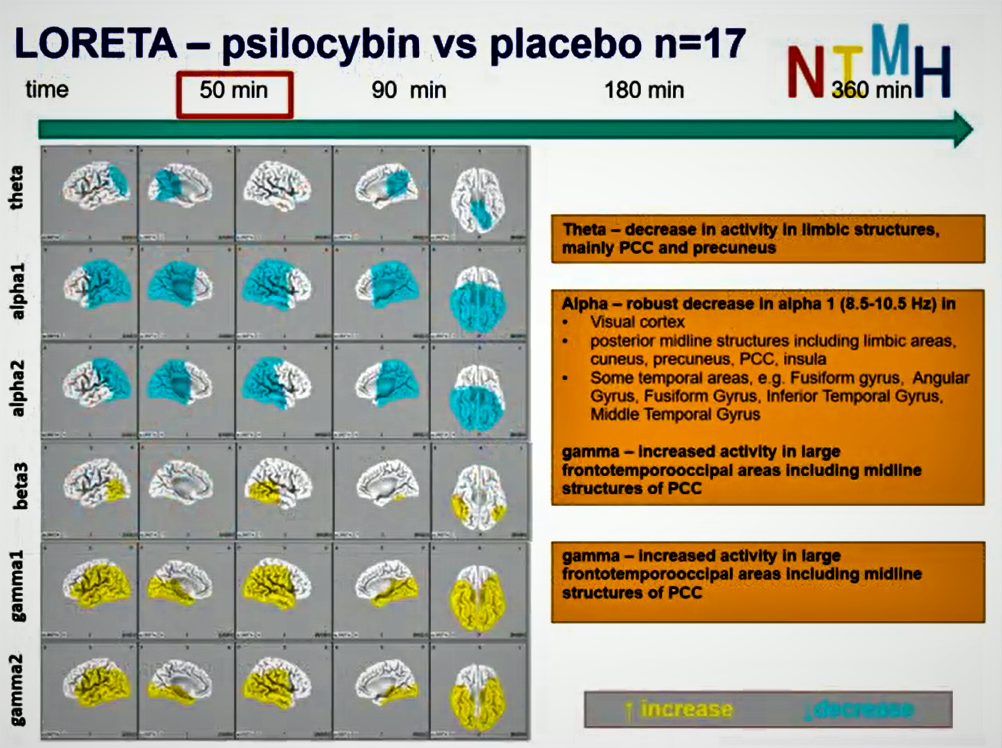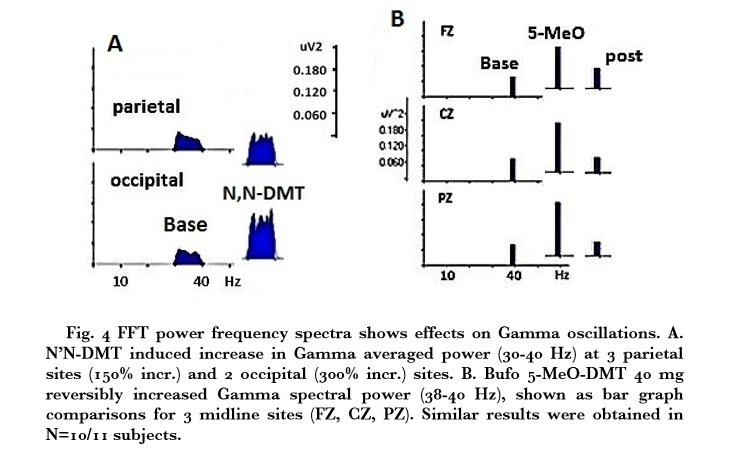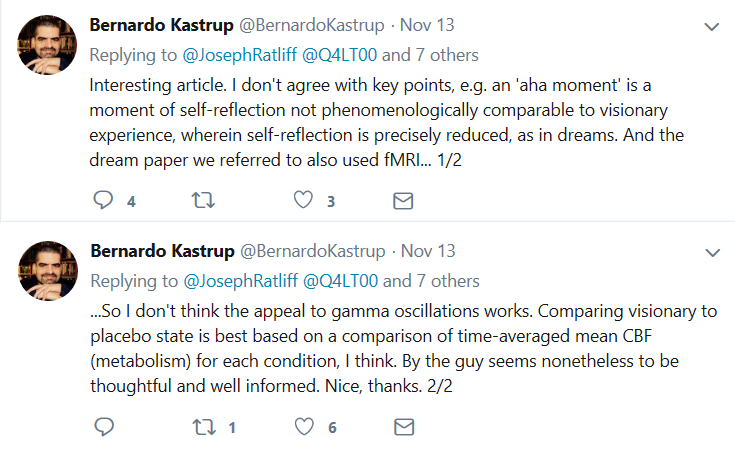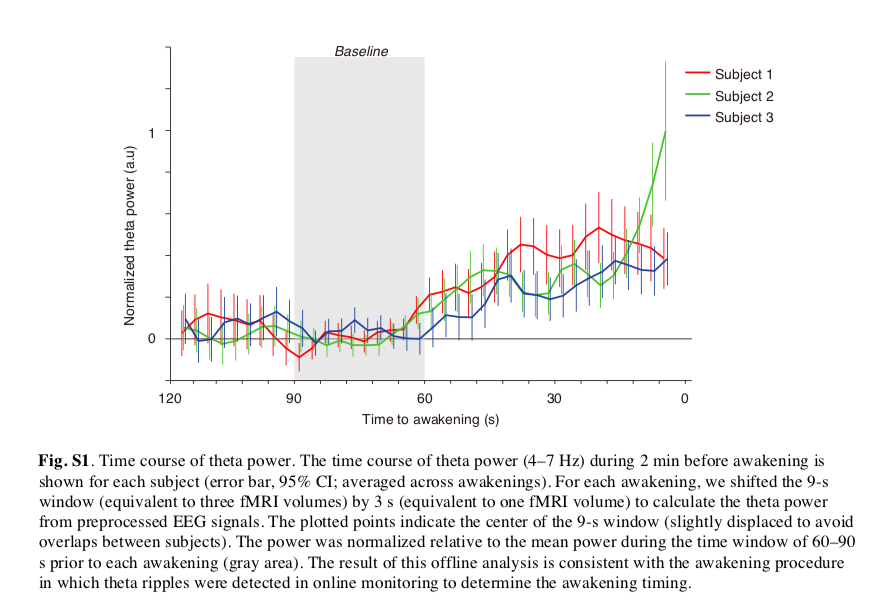Perspective is everything when it comes to a debate.
While discussions surrounding data generated using the scientific method and technological instruments should be somewhat straightforward, the differing perspectives is what we believe can cause these debates to go awry.
In recent times, philosopher Dr. Bernardo Kastrup has stirred up a discussion regarding the results of brain studies involving psychedelics. Kastrup has written extensively on the philosophical notion of idealism. Idealism is the concept that everything that takes place within the universe takes place in universal consciousness aka “the mind”. It proports that everything deemed as “physical” reality is based on our expectations and that the process of dissociation from “mind” is what forms the personal psyche. This insinuates that any facts and data generated by the scientific method/instruments is merely a correlate to an experience. The philosophy doesn’t grant the notion that any specific input of an experience is the source of the experience itself.
By contrast, the study of the brain and body by neuroscientists and biologists attempts to measure physiological changes that coincide with an experience, effect, or state of being. In the case of the psychedelic studies at Imperial College, they are studying the neurological changes that take place following administration of psilocybin, DMT, and LSD. The researchers appear to be interested in generating data that helps explains the significant emotional benefits of these experiences. Theoretically speaking, this could lead to the possibility of the legalization of these substances in order to benefit the general public.
These differences in perspectives between Kastrup and the Imperial College research team presents a difficult chasm to cross in terms of a reasonable or even warranted starting point for productive discourse.
Let us continue…
The following is a Twitter thread between Kastrup and Dr. Enzo Tagliazucchi (a neuroscientist of the Imperial College psychedelic studies) regarding Kastrup’s post titled “The Fix is Worse than the Problem: A Reply to Psychedelic Researchers”. This post was a reply to the Imperial College team’s essay titled, “What Psychedelic Research Can and Cannot tell us about Consciousness” which was a response to Kastrup’s post titled, “Misreporting and Confirmation Bias in Psychedelic Research”.
We know… it’s getting quite convoluted.

PubMed search regarding psychedelics and electroencephalogram (EEG) measurements reveals the following:
Excerpt from a 2015 human psilocybin study published in the journal Pyschopharmacology: “In contrast to these strong decreases in low-frequency oscillations, there were no psilocybin-induced effects on current source density in the gamma1 frequency band (30–45 Hz). High-frequency oscillations (55–100 Hz) were significantly increased by psilocybin in the left RSC (BA29) during the eyes-closed condition (pmax=0.020). At a trend level (p=0.1, corrected), this psilocybin induced increase extended into the parahippocampal gyrus . In the eyes-open condition, there was a trend (pmax=0.054,corrected) toward a psilocybin-induced increase in current source density in high-frequency oscillations (55– 100 Hz) in the RSC (BA29).”
Excerpt from a 2016 human psilocybin study published in the International Journal of Neuropsychopharmacology: “Psilocybin decreased the EEG spectral power in alpha frequency band, however increased the power of gamma oscillations. The LORETA analysis revealed the source of decreased alpha in midline parietal structures and occipital lobes. The increase in higher frequencies was pronounced in large temporal areas.”
(EEG results from a not yet published 2017 psilocybin study by Dr. Tomas Palenicek)

Excerpt from a 2013 rat LSD study published in the journal Psychopharmacology:
“LSD (0.03–0.3 mg/kg) and DOI (0.5–2.0 mg/kg) increased the power and reduced the frequency of high frequency oscillations (130–180 Hz). In contrast, the hallucinogens produced a robust reduction in the power of low (40–60 Hz), but not high gamma oscillations (70–90 Hz).”
Excerpt from a 1998 human Ayahuasca study published in the journal Phytomedicine:
Post-ingestion, we observed increases in power in the 36 – 44 Hz frequency band (“40 Hz”) from the left occipital-temporal-parietal scalp electrodes in the eyes-closed condition, which extended to most of the posterior scalp in the eyes-open condition. The results are consistent with many reports that ayahuasca intensifies visual imagery. These results are discussed in terms of a thalamocortical model of the role of 40 Hz activity in brain function and conscious experience.
Excerpt from a 2005 human Ayahuasca study published in The Journal of Psychoactive Drugs: EEGs recorded during visual imagery was compared to eyes-closed baselines. The most important findings were increases in global EEG coherence in the 36-44 Hz and 50-64 Hz frequency bands for both subjects. Widely distributed cortical hyper-coherence seems reasonable given the intense synesthesia during ayahuasca experiences
Excerpt from a 2015 human Ayahuasca study published in PLOS One:
Employing a combination of electroencephalogram (EEG) recordings and quantification of ayahuasca’s compounds and their metabolites in the systemic circulation we found ayahuasca to induce a biphasic effect in the brain. This effect was composed of reduced power in the alpha band (8–13 Hz) after 50 minutes from ingestion of the brew and increased slow- and fast-gamma power (30–50 and 50–100 Hz, respectively) between 75 and 125 minutes. Alpha power reductions were mostly located at left parieto-occipital cortex, slow-gamma power increase was observed at left centro-parieto-occipital, left fronto-temporal and right frontal cortices while fast-gamma increases were significant at left centro-parieto-occipital, left fronto-temporal, right frontal and right parieto-occipital cortices.
This is figure 4 from a 2015 EEG study regarding N,N-DMT and 5-MEO-DMT that observed increases in gamma waves from both compounds.


This is public confirmation that Dr. Kastrup is now aware of the consistent increases in gamma oscillations coinciding with psychedelic experiences. This alludes to the notion that Dr. Tagliazucchi was correct in remaining tempered regarding the claim by Kastrup that higher oscillatory power has never been measured alongside psychedelic administration. Whether the Imperial team was able to decipher the gamma activity in their own study is irrelevant to the conversation being that there are multiple supportive periphery studies. In fact, the notion that slow wave decreases occur synchronously with fast wave increases during psychedelic experiences is not a “new” finding being that this had been observed since the 1970’s with LSD. The surprising aspect to us is how quickly Kastrup dismissed increased gamma activity as not being a correlate to the visionary experience when we presented the data to him.
(A chart showing the differences in oscillatory activity that coincides with changes in perception/experience)

From a “brain/materialistic” perspective… when looking at the descriptive brain wave chart above and considering the experiential intensity of the psychedelic experience… it makes logical sense to us that we would see an increase in either theta and/or gamma waves. Based on the mechanisms of inducing theta and acknowledging the experiential effects of deep relaxation, it doesn’t resonate heavily with psychedelics which are more visually excitatory/stimulatory by nature (in our opinion). When taking in the amount of visual information being assimilated as well as the insights being reported from hallucinogens… gamma wave increases appear to integrate quite nicely from a theoretical mechanistic perspective.
(Not to overwhelm the readers but theta oscillations have been observed to act as “carrier waves” for gamma oscillations. During dreams, meditation, and hypnosis (endogenously induced altered states) the coupling of both theta-gamma waves have been observed. We will go into more detail regarding this in part 2.)
“I don’t agree with key points, e.g. an “aha” moment is a moment of self-reflection no phenomenologically comparable to visionary experience, wherein self-reflection is precisely reduced, as in dreams.“ – Kastrup
Another perplexing aspect to us is how Kastrup is deducing the precise experiential effects that coincide with gamma waves. This is based on the simple fact that the range of gamma waves is so wide starting from the 30 Hz region up to 1000 Hz (and potentially more). This doesn’t even begin to take into consideration the specific localization/origin of the gamma wave activity that coincides with the experience. A gamma wave of 55 Hz that originates in the left temporal lobe will surely have unique experiential differences to a gamma wave of 35 Hz that originates in the retrosplenial cortex (RSC). The same exact logic can be interlaced when discussing the slower waves of Alpha, Theta, and Beta waves. Nobody in the world (Kastrup included) has the neurological expertise to definitively state that a surge in 8 Hz equates to the same exact experience as a surge in 14 Hz even though both oscillations fall in the Alpha range. To go even further… nobody can state that an 8 Hz Alpha surge in the left prefrontal cortex in one person leads to the same exact experience of another person experiencing an 8 Hz Alpha surge in the same exact brain region. They can be similar states of being but to automatically assume that the subjects are having the same exact experience is flawed logic as it pertains to human neurology and the human experience.
Kastrup’s example of not agreeing with the key points such as gamma oscillation based “Aha” moments as not being phenomenologically comparable to a visionary experience is not very well researched in our opinion. The only reason why we included the “Aha” moment study regarding gamma waves was to show that initial neuronal binding appears to be initiated by gamma waves leading to the creation of new neural pathways. The example was given to show the likelihood that faster frequency oscillations are important in terms of neuronal connectivity, neuroplasticity (extremely pertinent to the psychedelic discussion), neurogenesis, and information processing. The “Aha” moment-gamma correlation example had nothing to do with reducing the occurrence of gamma oscillations to only coinciding with “Aha” moments as it seems that Kastrup had deduced. It is impossible to reduce a bandwidth of oscillations that range from 30 to 1000 Hz as being solely one type of experience.
It’s also a bit difficult to comprehend where Kastrup derives the conclusion that gamma waves coinciding with “Aha” moments are self-reflective and since visionary states (eg. dreams) apparently coincide with precisely reduced self-reflection (need a source for this statement) it is therefore unlikely that gamma waves play a role in visionary experiences. The research seems to indicate otherwise which we will outline below…
A lucid dream is a dream during which one is aware that they are dreaming. During a lucid dream, a person may gain some amount of control over the dream characters, narrative, and environment. A 2009 study published in Sleep observed the following regarding lucid dreaming: “Results show lucid dreaming to have REM-like power in frequency bands delta and theta, and higher-than-REM activity in the gamma band, the between-states-difference peaking around 40 Hz. Power in the 40 Hz band is strongest in the frontal and frontolateral region. Overall coherence levels are similar in waking and lucid dreaming and significantly higher than in REM sleep, throughout the entire frequency spectrum analyzed.”
So we have two studies that indicate that the gamma wave band is pertinent to lucid dreaming that takes place naturally (endogenously) as well as externally induced lucidity. It therefore seems contradictory to the statement that Kastrup made regarding self-reflection being distinctly reduced in dreams and therefore being incomparable to “Aha” moments. In terms of visionary experiences and gamma oscillations… there actually appears to be a tight correlation between the two based on casually perusing the data.
A 2004 study in the European Journal of Neuroscience observed “maximal cortical power in the gamma range (30-60 Hz) confined to the region of the primary visual cortex in response to induced visual illusions”.
A 2006 study in the journal Neuroimage observed time based increases in visual gamma band activity in the visual cortex coinciding with time based visual stimulus.
A 2012 study in the Journal of Neuroscience observed that frequency of gamma oscillations are predicated on the size of the visual cortex.
A 2013 macaque monkey study published in Cerebral Cortex observed an increase in gamma wave power in the visual cortex coinciding with visual exposure to images of nature.
A 2015 study in the Journal of Neurophysiology found that the frequency of gamma oscillations is modulated by the velocity of visual motion.
A 2016 study in PLOS One found that “gamma frequency increased with stimulus eccentricity”.
A 2018 study published in The Journal of Neuroscience observed that large visual stimuli induced an increase in two distinct gamma oscillation bands in the visual cortex of primates and humans.
A 2018 study published in Neuroimage found that spatial attention modulates visual gamma oscillatory activity in the visual cortex.
Apparently there appears to be a definitive relationship between gamma oscillations, the visual cortex, and visual stimulus. Based on the fact that hallucinogens induce visionary states, it should offer no surprise that gamma oscillations are altered following the ingestion of these substances.At this point, it is still a bit perplexing to us as to how Dr. Kastrup got involved in discussing brain imaging data in regards to the philosophy of idealism. It simply is not clear to us how any scientific data pertaining to brain function can help or hurt the adoption of idealism for those interested in philosophy. Nevertheless… let us continue.“And the dream paper we referred to also used fMRI so I don’t think the appeal to gamma oscillations works.” – Kastrup
We’re aware that fMRI was utilized in the study they are referring to. The question we had was pertaining to the following statement made in Scientific American regarding the study: “The problem is that modern brain imaging techniques do detect clear spikes in raw brain activity when sleeping subjects dream even of dull things such as staring at a statue or clenching a hand. So why are only decreases in brain activity conclusively seen when subjects undergo psychedelic experiences, instead of dreams? Given how difficult it is to find one biological basis for consciousness, how plausible is it that two fundamentally different mechanisms underlie conscious experience in the otherwise analogous psychedelic and dreaming states?”
I e-mailed the following to Kastrup: My question is in regards to the sleep study that you cited (which I’ve attached) and more specifically this sentence “modern brain imaging techniques do detect clear spikes in raw brain activity when sleeping subjects dream”. Can you clarify which part of the study showcased these spikes in activity?
Kastrup replied: As you likely saw in the study, the researchers trained decoders to identify fMRI patterns of visual cortex activations associated with perceiving certain visual stimuli while awake. These decoders could then identify the same patterns of fMRI brain (re)activations, in the same areas of the brain, while subjects were having hypnagogic or non-REM dreams; to the point that the researchers could even predict specific dream contents. EEG was used to decide when to wake subjects up so they could verbally report their dream imagery, since their non-REM dreams correlated with a specific EEG signature (namely, significant increases in power in the theta band, 4-7 Hz, as shown in Figure S1 of their supplemental materials). fMRI readings were done continuously before awakening. The researchers concluded:
“Together, our findings provide evidence that specific contents of visual experience during sleep are represented by, and can be read out from visual cortical activity patterns shared with stimulus representation. Our approach extends previous research on the (re)activation of the brain during sleep… The results suggest that the principle of perceptual equivalence, which postulates a common neural substrate for perception and imagery, generalizes to spontaneously generated visual experience during sleep.” (emphasis added)
Neither these fMRI patterns of (re)activation nor theta band power increases were observed in the psychedelic studies. These are the activations we’ve referred to.
JC: Thanks for the clarification Dr. Kastrup. Spikes in theta band are very consistent with endogenously produced altered states. Theta appears to act as a carrier wave to gamma waves at they work in a coupling manner. Exogenously produced altered states generally appear to bypass theta altogether and go straight to gamma. Do you happen to have the supplement to this article. It would be called “Materials and Methods”. The details of the study regarding theta are found there I believe which I don’t have access to.
Kastrup: There is a link to it at the end of the paper, if you purchased it: http://science.sciencemag.org/content/suppl/2013/04/03/science.1234330.DC1.
I have it, but these things usually are watermarked with the information of the purchaser. The relevant graph is below.

JC: I just wanted to confirm that when you refer to “spikes” it is purely from the theta increase measured via EEG and not the fMRI data?
Kastrup: No, see my original message
JC: I suppose I’m just not understanding the reference to “clear spikes in raw brain activity”. I understand that there were fMRI correlates (an average of 60% accuracy) with the experience of perceiving a visual image during non-REM sleep. Are you stating that these fMRI correlates are the “clear spikes” you are referring to that has nothing to do with the EEG based Theta increase? Sorry for the follow ups but I just want to be very clear on your perspective.
Kastrup: I don’t know what to add to my clarifications and the paper plus its supplementary materials. So I guess I’ll just leave at this.
To be honest… it is still not clear to us as to what specific piece of data Kastrup is referring to when he utilized the phrase “clear spikes in raw brain activity”. We searched the original study as well as the supplement and nowhere within either paper do the researchers utilize the term “spike”, “surge”, blood flow, CBF, BOLD, or even “increase” (pertaining to the brain activity) anywhere. Based on the lack of temporal resolution regarding fMRI, it doesn’t make sense that patterns of (re)activation would be the source to support the notion of the term “spike”. If anything, it appears that the increase in theta oscillations is the clear source for the term being that a clear increase was observed prior to the image recall. The researchers didn’t attempt to measure any oscillatory activity outside of the theta bandwidth. The point of clarifying the phrase “spikes in raw brain activity” is based on the fact that Kastrup consistently touts data from psychedelic based fMRI studies to support his criticisms of materialism based perspectives of neurology. However, in his example of inconsistencies in brain activity between dreams and psychedelics it appears that he integrated EEG data to support his point. If one chooses to utilize EEG to support an argument… then it’s only fair that EEG data can also be utilized to refute the same argument.
There is no cherry picking data in scientific discussions.
“In both science and philosophy one must extract conclusions not from local and partial pieces of the data, but from a careful consideration of the data as a whole. One must look for broad patterns, because it is from these broad patterns that reliable conclusions can be extracted.“ – Dr. Kastrup
Data as a whole is a must as we attempt to make sense of the non-binary, non-linear machine known as the human body. Reasonable hypothesis’ can only be generated when utilizing every piece of data available from every different measurement device available.
We believe Dr. Kastrup to be a rational person with good logical and analytical abilities.
The term “pot committed” is utilized in the game of poker once you’ve arrived at a hand at which folding to any bet or raise has become an incorrect play. In some regards it appears as though Dr. Kastrup has become pot committed to his blanket statement of “decreased brain activity” during transcendental states. Having read through some of his written work and videos, it’s clear that he has been touting this for five years or more.
The question is whether Dr. Kastrup is already pot committed to a point of being incapable of folding his “hand” that states that only decreases in allmeasurable types of brain activity (oscillations, blood flow) coincides with transcendental experiences. The specific data points already exist that negates this specific statement.
“Comparing visionary to placebo state is best based on a comparison of time-averaged mean CBF (metabolism) for each condition, I think.” – Kastrup
We don’t know from where or how Kastrup deduces that the fMRI is the “best” measurement device to compare visionary to placebo states but we will be addressing this in Part 2 as well as a deep dive regarding the disconnect between fMRI data and oscillatory activity… stay tuned!
DMT Quest is a non-profit 501(c)3 dedicated to raising awareness and funds for endogenous DMT Research. This specific field of psychedelic research has been underfunded for many decades now. It’s time to take our understanding of human physiology, abilities, and perception to the next level. E-mail me at jchavez@dmtquest.org with any comments or questions. You can also follow us at Facebook, Instagram, or Twitter.
